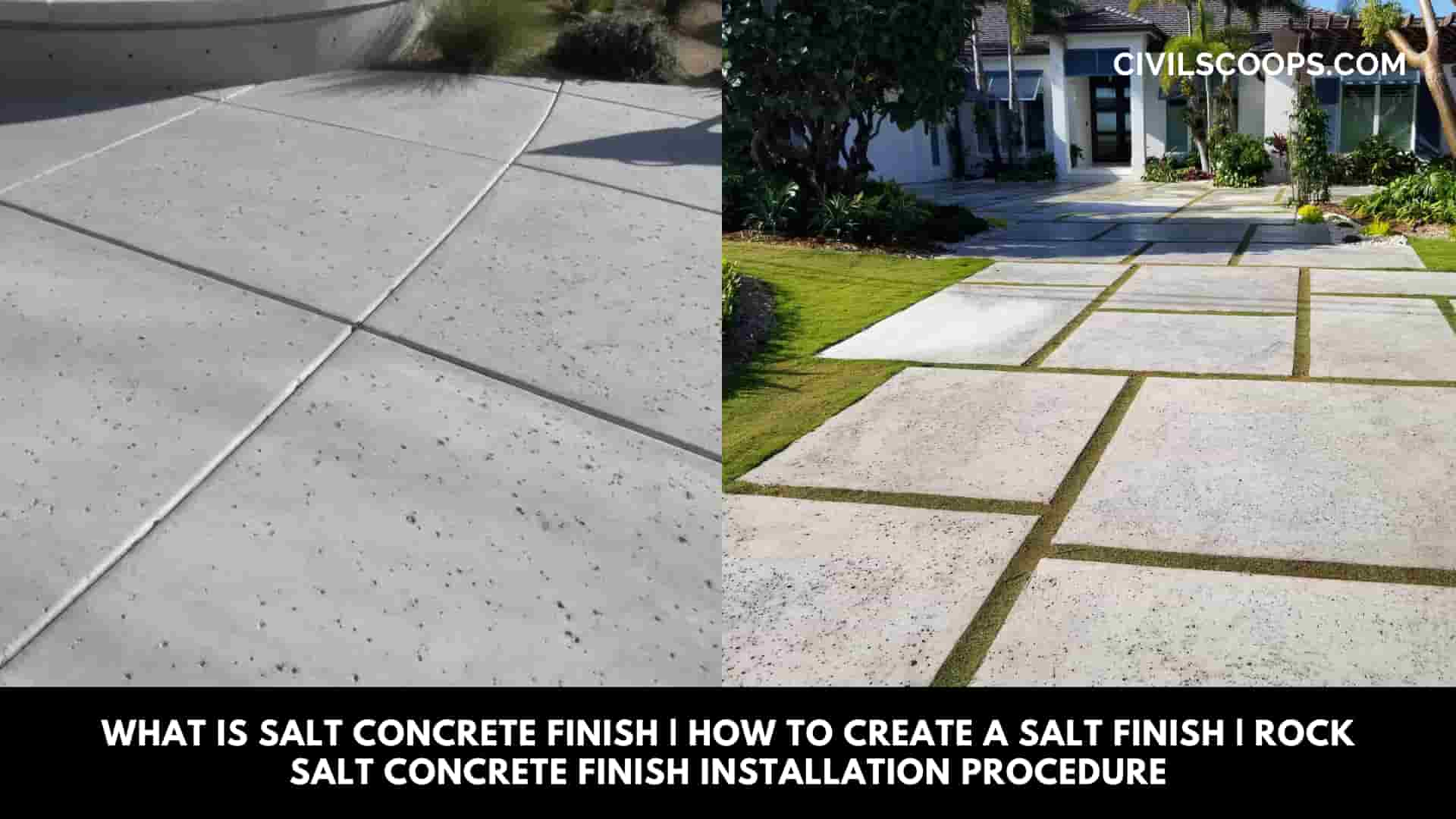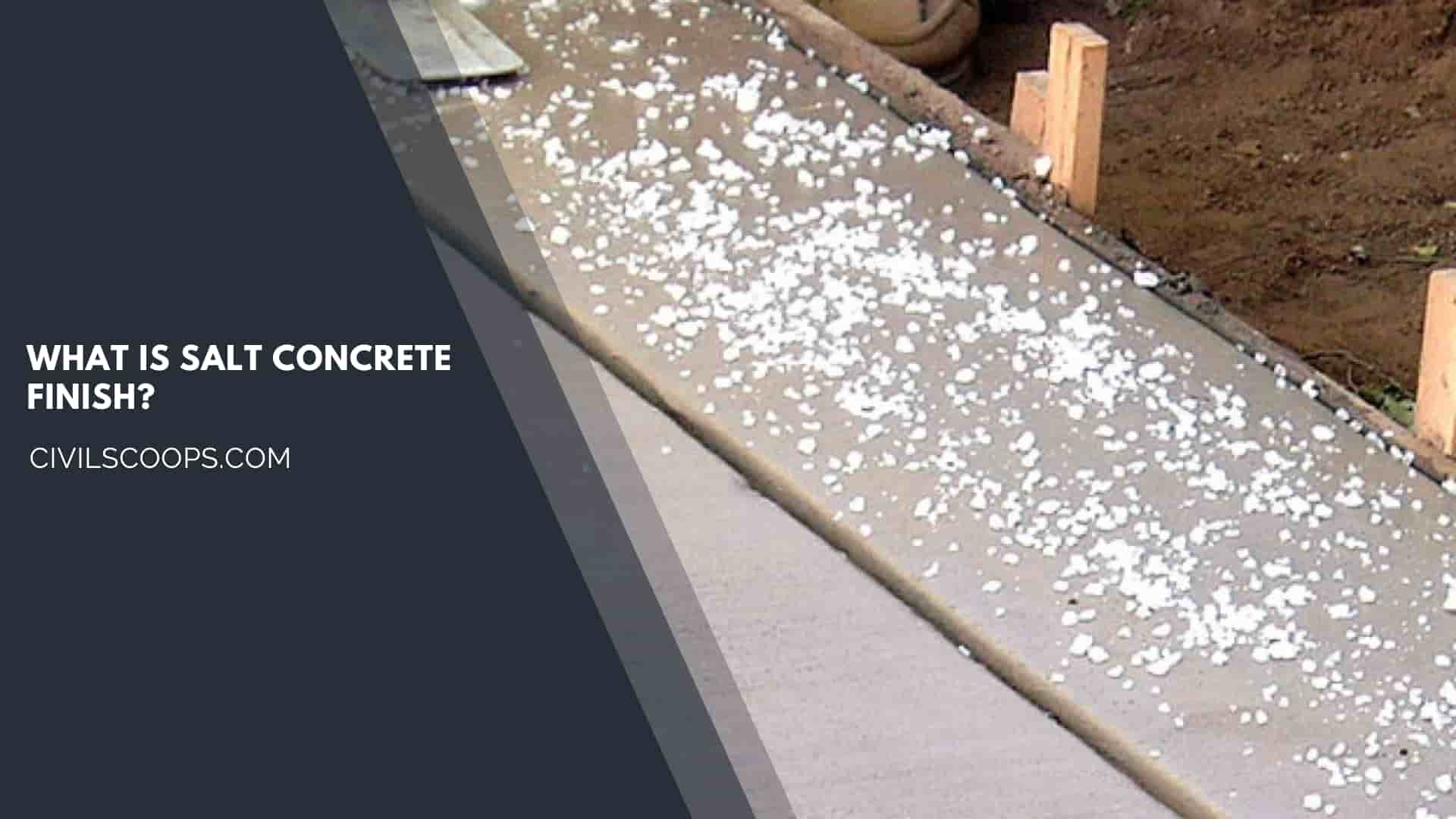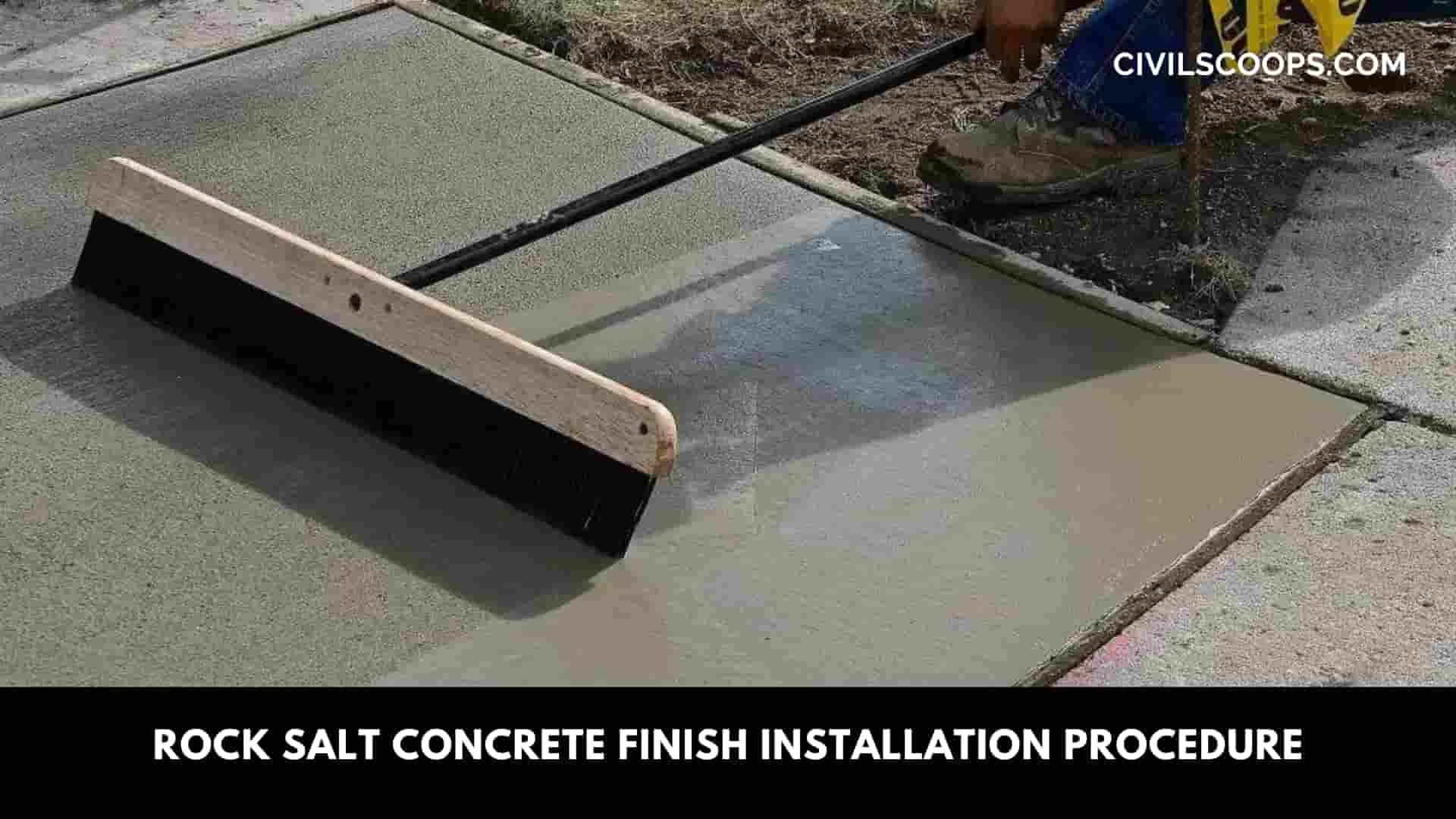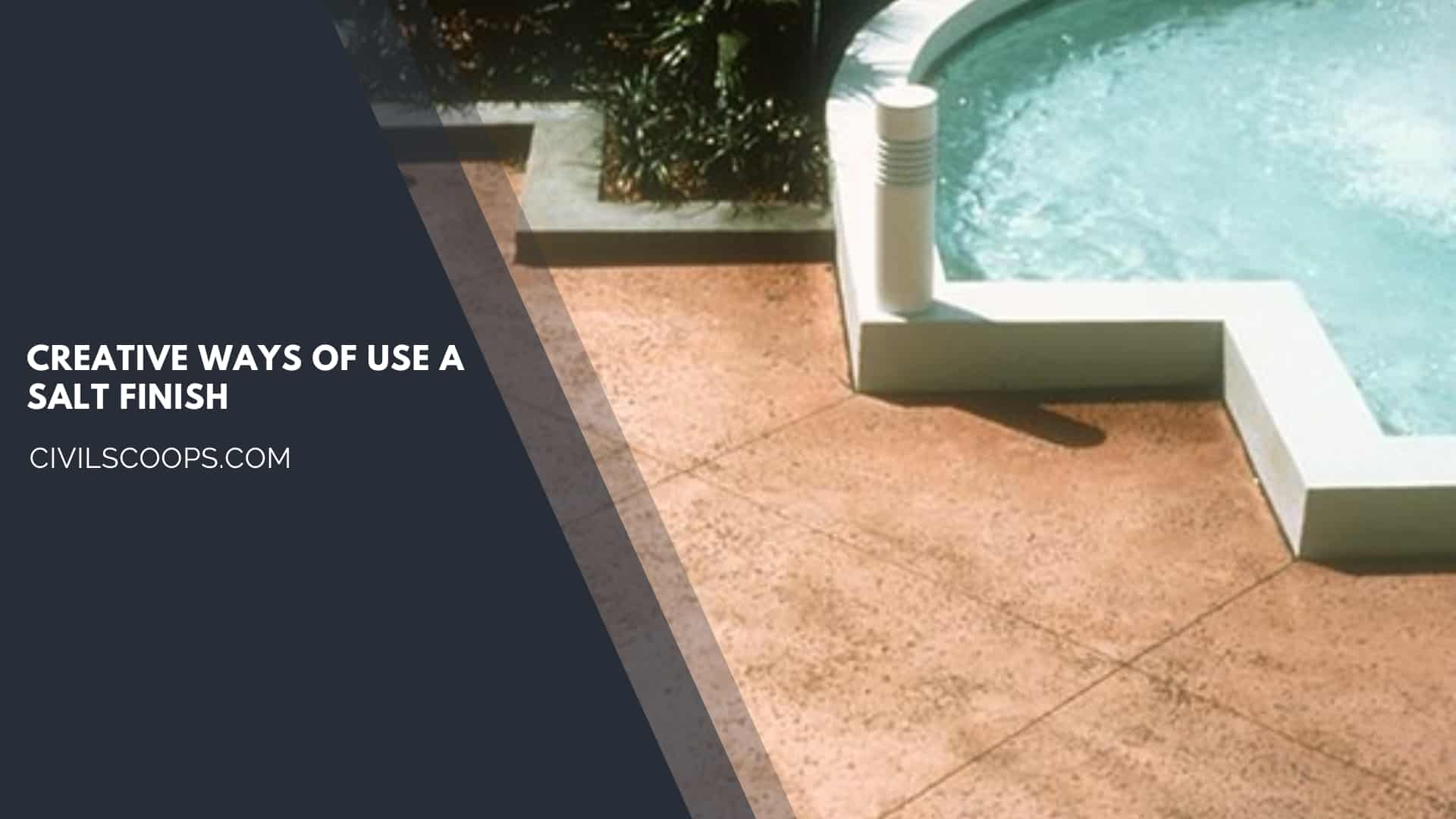What Is Salt Concrete Finish | How to Create a Salt Finish | Rock Salt Concrete Finish Installation Procedure

Table of Contents
What is Salt Concrete Finish?

As one of the older, more conventional decorative concrete finishes, salt finish concrete has become the most popular in unfreezing / thaw regions around the country.
For a little additional cost, you can add texture to just about any hardscape. With the popularity of decorative concrete along with the wide range of decorative finishes available today, the salt finish is not used much currently.
However, Lance Boyer, owner of Trademark Concrete Systems, Oxnard, Calif., says that they occasionally see the finish specified on plans, adding that it is sometimes specified in areas between characteristic panels using more expensive decorative finishes.
The salt finish is more decorative than broom finished concrete, which is often the alternative consideration.
Landscape architects who need concrete to look like concrete tend to specify salt finishes for that reason.
Rock Salt Concrete Finish Installation Procedure

Installing salt finish concrete requires little extra material or equipment-rock salt, and a roller to press it on the surface of fresh concrete is it.
Sometimes an installation also involves colored concrete with either integral or dry-shake color hardeners. As with most decorative finishes, the timing for the installation is critical.
There’s little difference about finishing and placing concrete in preparation for a salt finish. During the bull-floating operation, care ought to be taken to remove the lines created by the float.
Finishers often finish a slab either with Fresnos or using hand trowels to get a smooth finish to record the print of the salt better. Make sure to finish just after the water sheen has disappeared from the surface.
For the best results, workers should broadcast salt once the concrete is just beginning its initial setting phase. The stiffness of the concrete needs to be the same as it would be for stamping textures or patterns.
If you push your finger with moderate pressure to the surface, it must penetrate approximately 1/4 inch at most.
Some finishers also gauge timing by lightly pressing the surface to see if concrete paste or colour sticks for their finger–proceeding when there’s no residue in their finger. Rock salt rated as”coarse” or”extra coarse” would be the most popular sizes to use.
Because it’s broadcasted by hand in a similar way to throwing dry-shake colour hardeners, skill is required by the worker to achieve an even distribution.
Having good access around the work area also is important, so broadcasting is limited to 15 or 20 lineal feet.
Also Read: What Is Spalling Concrete | Causes of Spalling in Concrete | Repairing Concrete Spalding
How to Create a Salt Finish?

As its name implies, a salt finish is traditionally achieved with the same coarse rock salt sold to be used in water softeners or as a deicer in winter.
Concrete finishers broadcast the salt particles over moist concrete and then press the grains to the surface using a roller or float.
After the concrete sets (Final Setting Time of Concrete), they power wash away the salt, revealing a speckled pattern of shallow indentations left by the dislodged salt particles.
While salt is relatively quick and easy to master, there are newer methods which may speed up the procedure for doing away with the salt altogether.
Salt finishes are more commonplace in the warmer southern and western regions of the country. The reason in areas subject to freezing weather, water will accumulate from the indentations and freeze, potentially causing spalling.
But if you like the look and use of good-quality concrete protected by a waterproofing sealer, a salt finish ought to be durable enough to endure any climate.
Also Read: All About Drywall Water Damage Repair
Creative Ways of Use a Salt Finish.

Salt finishes are attractive alone but are particularly stunning when used in combination with coloured concrete and other decorative finishes.
Some contractors who specialize in stamped concrete usage salt finish as an interesting contrast to brick and stone patterns.
Landscapers have long relied on salt finishes to create rustic garden pathways with the look of natural stone. And the finish is still quite popular with pool contractors, owing to its inherent nonskid texture.
Other Creative Ways to Use a Salt finish Concrete:
- As a decorative Edge for swirl-troweled or broom-textured concrete
- In large panels bordered by bands of smooth concrete
- To add texture to Coloured concrete overlays
- In square or diamond-shaped panel arrangements separated by scored or saw-cut joints
[su_box title=”FAQ” style=”default” box_color=”#333333″ title_color=”#FFFFFF” radius=”3″ class=”” id=””]
Salt Concrete
Salt-concrete is a building material that is used to reduce the water inflow in mining shafts in salt mines. It is composed of 16% cement, 39% halite, 16% limestone powder, 14% water and 15% sand.
Is Salt Bad for Concrete?
The answer is yes, salt does indirectly damage your concrete driveways, patios and sidewalks. Bumps and potholes don’t just appear due to regular wear and tear – salt damages concrete over time by causing corrosion to occur under the surface, leading to discolored, cracked and crumbling concrete.
Rock Salt Concrete Finish
Salt finish concrete surface is obtained by inserting coarse rock salt crystals using rollers on the freshly placed concrete surface and washing it off with streams of water after the concrete is set. This procedure gives a rough subtle texture and skid resistance to plain or coloured concrete.
Salt Finish Concrete
The term “salt finish” typically refers to a method used for finishing concrete surfaces, but it doesn’t involve actual salt application. Instead, it’s a way to add texture and visual appeal to the concrete surface.
Salt on Concrete
“Salt on concrete” typically refers to the practice of using salt as a de-icer on concrete surfaces during winter or icy conditions. When roads, sidewalks, driveways, or other concrete surfaces become covered with snow or ice, salt is often spread on them to melt the ice and improve traction.
What Is Salt Finish Concrete?
Salt finish concrete is a decorative concrete technique used to create a textured surface on the finished concrete. It involves the application of rock salt or other similar materials onto the surface of freshly poured concrete before it sets and hardens. Once the concrete is cured and the salt is removed, it leaves behind a distinctive pattern and texture.
How to Salt Finish Concrete?
- Prepare the Concrete Surface
- Apply the Salt
- Press the Salt into the Concrete
- Cure the Concrete
- Remove the Salt
- Clean and Seal (Optional)
Salt Finish Concrete Process
- Pouring Concrete
- Applying Salt
- Pressing Salt
- Curing
- Salt Removal
- Clean and Seal (optional)
Salt Finish Concrete Cost
However, for the more enterprising type, if DIY’d; the cost can go down tremendously to only a range of $1,000 or more. This is why this finish has become quite popular. The concept is pretty easy, the materials are readily available, and it can be DIY’d. Read more about our guide on salt-finish concrete pool deck here.
Rock Salt Concrete Finish Problems
Rock Salt Finish Concrete
- During low temperatures, there may be chances of water and moisture getting trapped on the surfaces.
- These moisture and water that trapped in the surfaces will increase the pressure which, eventually will cause cracks in concrete.
Salt Finish Concrete Pros and Cons
Pros of Salt Finish Concrete:
- Decorative appeal resembling natural stone or exposed aggregate.
- Improved slip resistance for safer walking.
- Relatively cost-effective compared to other decorative finishes.
- Low maintenance and durability when properly installed.
Cons of Salt Finish Concrete:
- Limited design options with somewhat random texture.
- Potential surface damage if not executed correctly.
- Requires skilled application by an experienced contractor.
- Salt corrosion risk in areas exposed to de-icing salts.
- Extended project timeline due to curing time.
Salt Finish Concrete Patio
Stamped concrete
Stamped concrete is the classic among decorative concrete finishes for patios. For decades, stamped concrete (also called textured concrete) has been incredibly popular for outdoor patios, pool decks, and sidewalks. Concrete is imprinted using special urethane tools.
Is Salt Finish Concrete Slippery?
The appearance of rocksalt finishes concrete is smooth and broom-finished, but it is slip-resistant which makes it a better and ideal material for a pool deck.
What to Use Instead of Salt on Concrete?
Here are some effective alternatives to help you thaw your frozen concrete surfaces and prevent dangerous falls.
- Calcium Magnesium Acetate (CMA)
- Urea (carbonyl diamide)
- Epsom Salt.
- Natural Fertilizer.
- Rubbing Alcohol.
- Sand or Litter.
[/su_box]
[su_note note_color=”#F2F2F2 ” text_color=”#333333″ radius=”3″ class=”” id=””]
Like this post? Share it with your friends!
Suggested Read –
- What Is Stone Masonry | Types of Stone Masonry
- All About Marble Flooring | What Is Marble Flooring | Types of Marble Flooring
- What Is Roof Replacement | What Is Roof Repair | Difference Between Roofing Repair and Replacement
- What Does Hail Damage Look Like on a Roof | Identifying Hail Damage to Your Roof | Wood Shingles Hail Damage
- What Is Asphalt Paving | Types of Asphalt Paving | What Does Asphalt Cost | Hot Mix, Warm Mix, and Cold Mix Asphalt
[/su_note]
Originally posted 2023-08-05 11:01:32.
